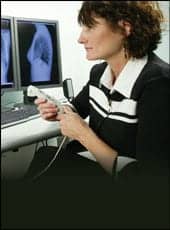By Kurt Woock
Mining huge volumes of data for specific strands of insight is no longer an activity relegated to backroom bean counters. On any given day, you might see a statistical breakdown of political data by budding media star Nate Silver, read about your favorite baseball team’s progress using complex formulas on ESPN, or track your personal finances using Mint.com’s comprehensive, colorful graphs. As more and more information is stored in digital form, the ability to extract value and meaning from the collective mass will be the true measure of digital migration’s success. iCenter from GE Healthcare, Waukesha, Wis, is one of these new tools that puts data to work.

Matt Costa is the CT manager at the University of California San Diego Medical Center. He is responsible for seven scanners at two sites. Together, he oversees a staff of 37 and about 33,000 annual exams. Costa first started using iCenter in 2011. “We had one 64-slice scanner that we were using 100% of the time—ER as well as outpatients,” he said. “In 2011, we opened a cardiovascular center. We had a 64-slice there as well.” The new scanner was covering ER patients and inpatients while the other scanner was just covering outpatients. “Before iCenter, it was difficult to see the flow,” he said. “On the RIS program that I use, I could see my department as a total, but it was complicated to separate the two scanners to see the numbers between the two.” Powerful new systems might have the capacity to add significant value on an individual exam basis, but without strategic equipment utilization over time, the systems will fail to reach their full potential overall.
Matt Costa, CT Manager, UCSD, Medical Center
In addition to the information from the scanners being lumped together, another problem was that the data was dependent on the techs entering it correctly. “If they brought a patient in the room and then forgot to start the scanner, and then started it later, it would look like it took less time,” Costa said. “The start and end times weren’t exact. The information was real—we had real numbers—but it wasn’t always accurate. The busier the techs are, the less accurate they are, and it’s because of all they need to do—turn over the room, make sure the injector is filled, etc.” UCSD had a backlog of about 7 days for outpatients. “On paper, it looked like they were busy. I couldn’t really see where I could efficiently add another patient slot.” The haziness that shrouded the true workflow was cleared up by iCenter.
In early 2012, the GE engineers who did preventive maintenance for UCSD suggested Costa try iCenter, which came with his service agreement. Now, Costa can see in real time what each scanner is doing. “From the minute a tech starts the exam to the minute they click out, there’s a graph that shows when the patient is on the table and where the holes are.” The system is an online service, so nothing needed to be downloaded to UCSD’s computers. The program works behind the scenes and doesn’t require any training of the staff. “If we have a delay in service, I can actually go in,” Costa said. “I can see on my RIS how many exams were done; I can use this as a secondary tool to see the actual table time. It tells you what the exam is and how long it takes. You can run reports and see how many exams each tech does, how many exams by type.”
Using the program shows Costa where gaps are. Seeing how long the exam actually took allows one to spot patterns. “Head CTs take 5 minutes, and then you’ll see one that took 20 minutes—there’s a problem with that exam,” he said. “You can go in and see why that exam screwed up the rest of your day.”
Using iCenter has yielded measurable improvements at UCSD. For example, Costa expected the new scanner to be used exclusively for ER and inpatient. “With this program, I realized that from 8 to 10 in the morning, the scanner wasn’t being utilized,” Costa said. As it turned out, the morning shift is light: there aren’t as many people there, and a nursing shift change means inpatients aren’t coming down. “When I realized nothing was going on then, I added four outpatient slots for each day.”
In another instance, Costa could see it took up to 20 minutes to get a patient on the table. “Well, technically, they were there for 5 or 10 minutes, but they were lying there getting their IV started,” he said. So, Costa added a nurse to the Thornton site to help with IVs. “Now, a patient comes in with an IV already started and the techs just need to check the patency and start the exam. Technically, I can do more patients because the techs aren’t starting IVs.”
By employing a relatively simple tool, Costa has been able to identify small changes that have led to significant savings and greater efficiencies. By pairing expanded capability with a better workflow, UCSD’s facilities—and its patients—benefit. The ability to translate the data into something usable made the difference.






